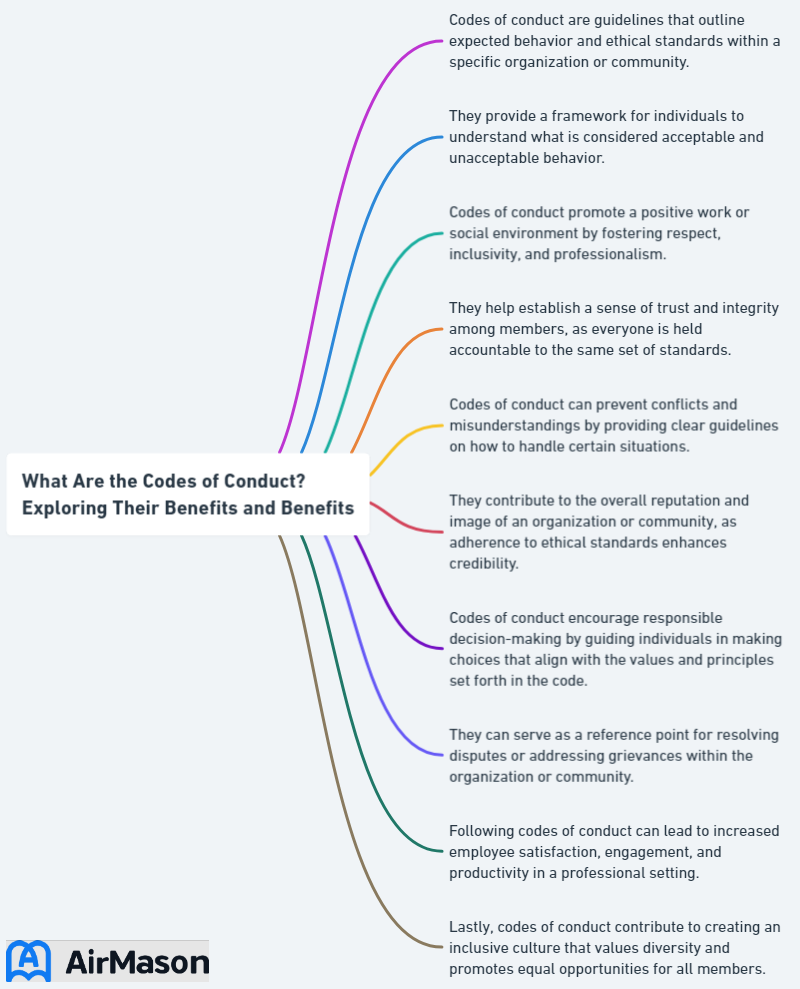
In today’s fast-paced business world, codes of conduct play a pivotal role in establishing an organization’s ethical foundation and guiding employee behavior. These essential guidelines not only create a harmonious work environment but also build trust with customers and partners. But what exactly are the codes of conduct and how can they benefit your organization? Let’s dive into this fascinating topic and explore how “what are the codes of conduct” can foster a culture of ethical decision-making, accountability, and integrity.
Key Takeaways
- A code of conduct is a set of guidelines outlining acceptable behavior and norms for employees.
- Creating an effective code requires assessing organizational needs, involving stakeholders, providing clear information and implementing training strategies.
- Leading companies provide real world examples to help create tailored codes that reflect company values and guide employee behavior.
Understanding Codes of Conduct
A company’s code of conduct serves as a beacon, illuminating the path to ethical decision-making and professional business conduct. At its core, a code of conduct is a written set of guidelines that outlines the acceptable behavior and norms for employees, embodying the organization’s core values and principles.
A clear structure within the code of conduct stimulates ethical business practices, thereby fostering business ethics and creating a secure and productive work milieu in the organization.

Defining Codes of Conduct
A well-crafted code of conduct, often found in a company’s employee handbook, should encompass company culture, values, and expectations, delineating employee responsibilities and stipulating internal and external policies. It serves as a point of reference for employees when navigating complex decision-making processes, positively influencing their behavior and that of their colleagues.
A code of conduct, when amalgamated with existing company policies, enables professionalism and uniformity throughout all departments and locations, adhering to the company’s code.
The Purpose of Codes of Conduct
The purpose of a code of conduct is to:
- Provide a framework for ethical decision-making
- Promote a positive work environment
- Reflect the company’s values and culture
- Illustrate behavior standards
- Display the organization’s commitment to discipline and professionalism
- Clarify the definition of misconduct for employees.
For example, a dress code policy may help employees understand what attire is considered appropriate, while a social media policy could guide their online interactions with customers and partners.
Code Conduct Examples
Code of conduct examples serve as essential guidelines for promoting a respectful and inclusive environment within various communities and organizations. These code conduct examples encompass a wide range of scenarios and behaviors, outlining expected standards of behavior for individuals. They address issues such as respectful communication, handling conflicts, and fostering a diverse and inclusive atmosphere. In software development, for instance, a code of conduct might encourage collaboration, discourage discrimination, and emphasize the importance of maintaining a positive and supportive community. It’s important to note that code of conduct examples can vary depending on the context and the values of the community or organization, but their common goal is to set a clear standard for appropriate behavior and ensure a harmonious and welcoming environment for all participants.
Components of an Effective Code of Conduct

Three key components – company values and culture, employee expectations and responsibilities, and internal and external policies – are vital to frame a comprehensive and effective code of conduct. This ensures the protection and proper utilization of company assets, not the company itself, while also guiding employees in posting company related content.
Organizations can devise a robust set of guidelines that foster a positive work environment and align with the organization’s mission and principles by addressing these elements.
Company Values and Culture
Company values and culture should be at the core of a code of conduct, serving as the foundation upon which employee behavior and decision-making are built. The framework of shared beliefs and values, provided by the company’s values and culture, sets employee expectations and guides their actions within the organization. This alignment between the code of conduct and the company’s values ensures that employees uphold the organization’s standards and ethics, ultimately contributing to a positive work environment.Employee Expectations and Responsibilities
It is essential that employee expectations and responsibilities be explicitly stated in the code of conduct to guarantee a shared comprehension of appropriate behavior. This section should address various aspects of employee behavior, including interactions with fellow employees, the use of company resources, and adherence to company policies.An outline of these expectations and responsibilities helps employees comprehend their roles better, contributing to a harmonious and productive work environment.
Internal and External Policies
The code of conduct should also encompass internal and external policies that address everyday business operations and interactions with external parties. These policies may cover a wide range of topics, such as dress code, data protection, and fair competition.Inclusion of both internal practices and external policies in the code facilitates a consistent approach to business conduct, safeguarding the company’s reputation, and fostering trust with customers, partners, and employees.
Code Ethics Example
An illustrative “code ethics example” is the widely adopted Software Engineering Code of Ethics and Professional Practice, which provides a framework for ethical conduct within the software development community. This code emphasizes key principles such as ensuring the public good and avoiding harm to individuals and society. For instance, it encourages professionals to prioritize the safety and well-being of users by developing secure and reliable software systems. Additionally, the code emphasizes the importance of maintaining integrity and honesty in professional relationships, striving for accuracy and rigor in all work, and respecting the rights of others, including intellectual property rights. By adhering to these ethical guidelines, software developers can contribute positively to society and establish a foundation of trust and accountability in the industry.
Developing a Code of Conduct for Your Organization

Creating a tailored code of conduct for your organization involves a careful assessment of organizational needs, the involvement of stakeholders, and a commitment to clarity and accessibility.
Following a thoughtful, inclusive process allows for the development of a code of conduct that aligns with your organization’s values and effectively guides employee behavior and decision-making.
Assessing Organizational Needs

- Assess organizational needs and identify key areas of concern.
- Evaluate the company’s risk profile and consider emerging issues.
- Consult with various departments to ensure compliance with laws and regulations.
Involving Stakeholders
Involving stakeholders, such as employees, management, the legal department, and business partners, in the development process is crucial to ensuring a comprehensive and relevant code of conduct. Their input helps to create a code that accurately reflects the values and expectations of all parties involved, fostering a sense of ownership and commitment to the guidelines.
Engaging stakeholders brings valuable insights and perspectives, contributing to a more effective and impactful code of conduct.Ensuring Clarity and Accessibility
A successful code of conduct should be clear, accessible, and easy to understand for all employees. To achieve this, avoid using jargon and provide examples when necessary to illustrate the expected behaviors and norms.Additionally, ensure the document is easily accessible in multiple formats and languages, allowing all employees to engage with the guidelines and apply them in their daily work. Focusing on clarity and accessibility results in a code of conduct that is easily comprehensible and accepted by the entire workforce.
Implementing and Enforcing a Code of Conduct

To ensure effective adherence to the guidelines, organizations must employ a combination of training, communication, monitoring, and reporting mechanisms.
Training and Communication
Training and communication are integral to the successful implementation of a code of conduct. Providing employees with the necessary resources and information enhances their understanding of their responsibilities and expectations under the code. Regular training sessions and workshops can help address any questions or concerns employees may have, reinforcing the importance of adhering to the guidelines.
Clear communication of the code’s importance and its impact on the organization’s culture and performance is essential for fostering a commitment to ethical behavior.
Monitoring and Reporting
Establishing monitoring and reporting mechanisms are crucial for tracking compliance with the code of conduct and identifying potential violations. Periodic audits, employee surveys, and anonymous reporting systems can help organizations detect and address any breaches in a timely and effective manner.
Maintaining a proactive approach to monitoring and reporting allows organizations to demonstrate their commitment to high ethical standards and a culture of accountability.Addressing Violations and Consequences
Addressing violations of the code of conduct promptly and consistently is essential to maintain the integrity of the guidelines. Applying appropriate consequences and reinforcing the importance of adherence to the code sends a clear message to employees about the organization’s commitment to ethical behavior.
Upholding the same standards for all employees and responding swiftly to violations enables organizations to cultivate a culture of trust and respect while minimizing potential risks and reputational damage.
Privacy and Code of Conduct
Privacy and code of conduct are crucial elements that guide behavior and interactions within various settings. The integration of a well-defined code of conduct within an organization or community ensures that individuals understand the expected standards of behavior and respect for privacy. Upholding privacy is not only a legal requirement but also a fundamental ethical consideration, emphasizing the importance of safeguarding personal and sensitive information. A robust code of conduct should explicitly address how privacy is handled, setting forth guidelines for data collection, storage, sharing, and access. By aligning the code of conduct with privacy principles, organizations can establish a culture of trust, transparency, and responsible conduct, promoting a respectful and secure environment for all stakeholders involved.
Real-World Code of Conduct Examples

- Amazon
- Microsoft
- Apple
- IBM
Summary
In conclusion, a well-crafted code of conduct is a powerful tool for fostering a culture of ethical behavior, accountability, and integrity within your organization. By focusing on company values, employee expectations, and internal and external policies, you can develop a comprehensive set of guidelines that effectively guide employee behavior and decision-making. Similarly, in the academic context, services like hausarbeit schreiben lassen can assist students in crafting well-structured and ethical academic papers, reflecting the rigor and integrity expected in scholarly work. By involving stakeholders, ensuring clarity and accessibility, and implementing robust monitoring and reporting mechanisms, you can create a code of conduct that not only reflects your organization’s unique values but also empowers your employees to contribute to a positive and productive work environment.
Frequently Asked Questions
What are the 5 codes of conduct?
The five codes of ethics are Integrity, Objectivity, Professional competence and due care, Confidentiality, and Professional behavior – all of which are essential components of a professional accountant’s conduct.
What are main codes of conduct?
A code of conduct typically contains internal practices, such as a dress code, job duties and training guidelines, as well as more value-based expectations related to company values, ethical behavior and employee rights. It should also provide details on responsibilities for employees, such as honesty about work commitments and equity and inclusion.What are the three basic codes of conduct?
The three basic codes of conduct are a compliance-based code, a value-based code, and a professional code of ethics.What are codes of conduct in the workplace?
An employee code of conduct is a legal document that provides guidelines on acceptable behaviors of individuals in an organization. It outlines the values and principles that guide employees’ conduct and interactions, such as communication, respect, honesty, confidentiality, diversity and inclusion, and conflict resolution. The code also specifies how team members should conduct themselves during work hours.